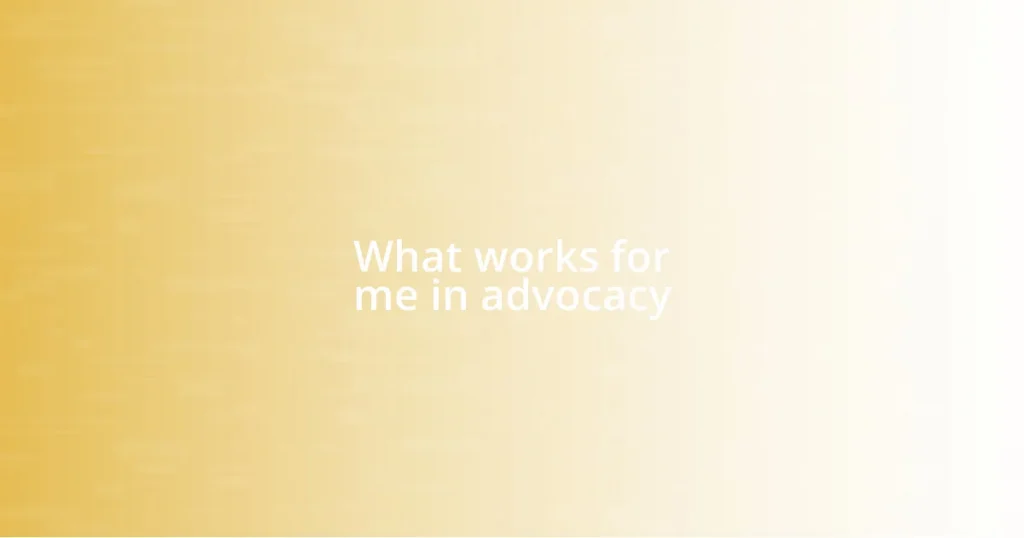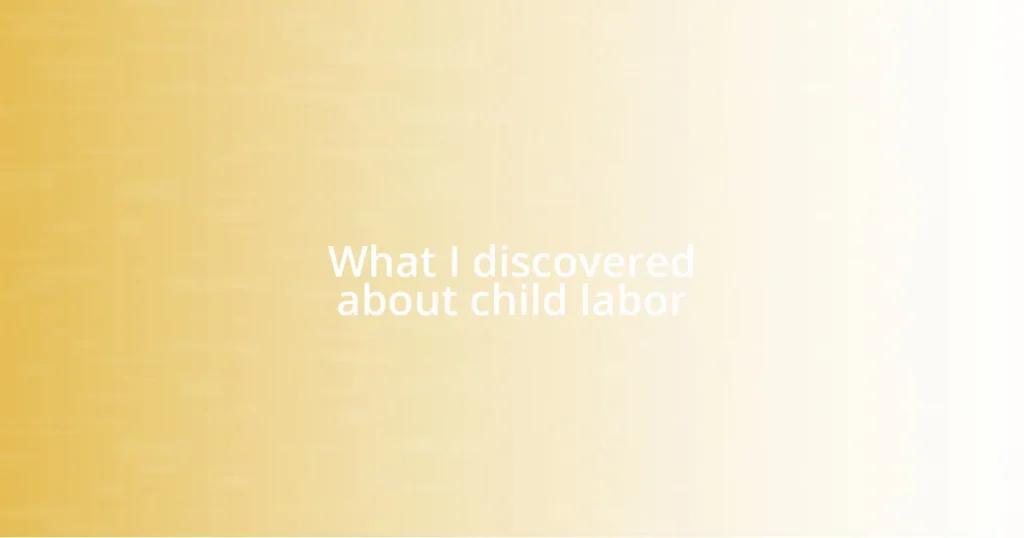Key takeaways:
- Passion and resilience are key indicators of potential youth leadership; observing how young people interact and overcome challenges reveals their leadership qualities.
- Understanding youth leaders’ needs and interests, as well as creating opportunities for personal growth, fosters effective connections and empowers them.
- Establishing open communication channels and encouraging feedback strengthens relationships and makes youth leaders feel valued.
- Celebrating achievements and maintaining long-term connections through informal gatherings enhance camaraderie and motivation among youth leaders.

Identifying potential youth leaders
When I started looking for potential youth leaders, I realized that passion is often the brightest indicator of leadership potential. I remember meeting a shy girl at a community event who had a spark in her eyes when she spoke about environmental issues. That spark is what makes someone stand out—it’s an energy that tells you they possess the drive to lead others.
Observing their interactions with peers can reveal a lot about young people’s leadership qualities. I once watched a group of teens plan a fundraiser, and one kid naturally stepped up to coordinate everyone. His ability to rally the group and inspire them to work towards a common goal was impressive. How often do we underestimate the power of observation in discovering leadership?
I believe that resilience is another characteristic to watch for when identifying youth leaders. I had a student once who faced numerous setbacks yet continued to support her classmates through their challenges. It’s this ability to overcome obstacles and uplift others that can truly define a leader. Doesn’t that make you think about the leaders in your own life?

Understanding their needs and interests
Understanding the needs and interests of youth leaders is vital for connecting with them effectively. During my time working with young people, I discovered that their aspirations often revolve around making an impact in their communities. For example, I remember chatting with a group of teens who were passionate about social justice issues. Their eagerness to discuss potential initiatives opened my eyes to the importance of listening deeply to what fuels their ambitions.
It’s essential to recognize that many youth leaders crave opportunities for personal and professional growth. A young man I mentored once expressed his desire to develop public speaking skills. I took note of this and arranged a small workshop, which not only boosted his confidence but also fostered a sense of belonging within the group. This experience taught me that by aligning support with their interests, you can empower them to flourish.
Moreover, understanding the common challenges they face can bridge the gap between us. I recall a conversation with a girl who felt isolated by her peers after proposing a new idea in a school meeting. By acknowledging her feelings and sharing my own past experiences of vulnerability, a connection formed that encouraged her to keep advocating for her vision. It’s remarkable how empathy can transform our interactions and foster leadership.
| Key Aspect | Examples |
|---|---|
| Passion | Discussions about community issues, environmental initiatives |
| Growth Opportunities | Workshops on skills like public speaking |
| Common Challenges | Feelings of isolation, advocating new ideas |

Establishing effective communication channels
Establishing effective communication channels is essential for fostering connections with youth leaders. I’ve learned that when I actively listen and create open lines of communication, it builds trust. Once, during a casual hangout, I asked a group of teens about their preferred ways to communicate. Their input surprised me; some preferred text messages for quick updates, while others valued face-to-face conversations. This simple inquiry allowed me to tailor my approach, ultimately enriching our interactions.
To enhance communication, I often implement a few specific strategies:
- Utilize Multiple Platforms: By using social media, email, and text, I ensure I’m accessible in various ways.
- Encourage Feedback: Regularly asking for their thoughts helps youth leaders feel valued and heard.
- Host Open Forums: Creating a safe space for discussion allows them to voice their concerns and ideas freely.
- Be Approachable: I make it a point to be present and available, so they feel comfortable reaching out anytime.
I found that engaging youth leaders in this manner not only strengthens our bonds but also empowers them to take ownership of their ideas and initiatives.

Creating collaborative engagement opportunities
Creating collaborative engagement opportunities is a dynamic process that thrives on inclusivity and creativity. I remember organizing a community clean-up event where I invited youth leaders to brainstorm ideas for projects. The energy in the room was palpable as they exchanged thoughts on how to tackle local environmental concerns. This collaboration wasn’t just about the eventual cleanup; it was about empowering them to take ownership of their initiatives. Wouldn’t you agree that when young people can see their ideas in motion, it ignites a fire within them?
In my experience, integrating fun activities can also elevate collaborative engagement. At one workshop, we mixed team building with goal-setting exercises. I watched as individuals who initially hesitated to speak up transformed into animated contributors, sharing personal aspirations and challenges. It reaffirmed my belief that a relaxed atmosphere fosters creativity and camaraderie. What if we always made space for this kind of growth-oriented environment?
Finally, I’ve found that regularly celebrating achievements, no matter how small, creates meaningful connections. I recall a project where we highlighted each participant’s contribution during a showcase event. The joy on everyone’s face as they recognized each other’s efforts reminded me that acknowledgment breeds motivation. Could it be that fostering a culture of appreciation is one of the simplest yet most powerful tools we have? Each of these experiences solidified my view that collaborative engagement is not only about working together but also about nurturing relationships that inspire and uplift.

Developing mentorship programs
Developing mentorship programs requires intentional planning and a clear vision of the outcomes we wish to achieve. I remember setting up a mentorship framework for a group of aspiring young leaders and realizing early on that the process isn’t just about skill transfer; it’s about creating genuine relationships. How can we ensure that these connections are meaningful? I’ve learned that aligning mentors and mentees by shared interests fosters a natural bond that makes learning much more enjoyable.
One of my most rewarding experiences was when I paired a high school student passionate about environmental science with a mentor who worked in sustainability. They dove deep into projects together, sparking a friendship that blossomed beyond the initial scope. Seeing them brainstorm ideas and support each other through challenges reminded me that mentorship is a two-way street; it’s about fostering growth for both parties. Have you ever witnessed such powerful connections? Those moments can truly change lives, highlighting how crucial it is to choose mentors who not only impart knowledge but also inspire.
In practice, I find it essential to regularly check in on the relationships within mentorship programs. Establishing structured feedback sessions helps ignite conversation and address any concerns early on. I once facilitated a feedback circle where both mentors and mentees shared their experiences. The breakthrough moments in those conversations were unforgettable. It’s fascinating how open discussions can uncover hidden treasures of insight, don’t you think? By creating a culture of continuous improvement, we ensure that mentorship programs evolve and deepen, making them lasting experiences for everyone involved.

Evaluating impact and adjusting strategies
Evaluating the impact of our initiatives is a crucial step in refining our strategies. I recall a specific moment when I took a step back after a community project to assess its outcomes. While the attendance was impressive, I realized that the youth leaders wanted to see tangible effects on their community. This insight prompted me to survey participants, gathering invaluable feedback that shaped our future projects. Isn’t it fascinating how sometimes the smallest data points can illuminate a clearer path forward?
Adjusting strategies based on evaluation results has transformed my approach over the years. When we took the time to analyze participation rates and the sentiments shared by youth leaders, it was eye-opening. I learned that simply hosting more events didn’t equate to greater engagement; rather, we needed to tailor our efforts to fit the specific needs and interests of the youth. By introducing smaller, interest-based focus groups, we cultivated deeper conversations and connections. Isn’t it amazing to witness the shift when initiatives become more tailored and personal?
In my experience, regularly revisiting our goals and methods is like fine-tuning a musical instrument. I vividly remember a time when we gathered as a team to assess our objectives. The conversations became a rich tapestry of ideas, highlighting the diverse perspectives among our youth leaders. It reinforced my belief that adaptability is key; when we embrace feedback and modify our strategies, we not only enhance our projects but also create an environment where everyone feels valued. Who wouldn’t thrive in a landscape that encourages growth and evolution?

Sustaining long-term connections and support
Sustaining long-term connections with youth leaders goes hand in hand with ongoing nurture and support. I remember a time when a former mentee reached out years after our initial connection, seeking guidance on a leadership role. It struck me how powerful our earlier conversations had been, creating a bond that lasted beyond our formal mentorship. This experience reinforced my belief that fostering relationships requires not only intention in the beginning but also consistent check-ins to keep those ties alive. How often do we think about the impact of a simple message or phone call?
In my journey, I’ve found that creating a shared space for youth leaders to connect regularly can strengthen these relationships immensely. One initiative I implemented involved monthly coffee chats, where young leaders could share their challenges and triumphs in an informal setting. I’ll never forget the spark in their eyes during these sessions; the sense of camaraderie they developed was palpable. These informal gatherings provided a platform for collaboration and mutual support, proving that sometimes, the best connections happen outside structured events. Have you ever experienced that sense of community forming organically?
Moreover, I believe that acknowledging milestones, both big and small, plays a crucial role in maintaining long-term support. Celebrating achievements fosters a sense of belonging and boosts motivation. I vividly recall organizing a small awards ceremony for emerging leaders, where we recognized their hard work and dedication. The joy in their shared laughter as they accepted their awards was truly unforgettable. It reminded me that appreciation creates lasting bonds—relationships that evolve from recognition of each other’s efforts. Don’t you agree that celebrating successes can solidify connections like nothing else?














